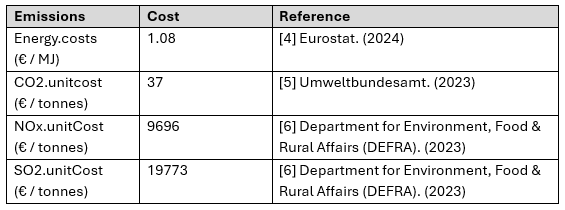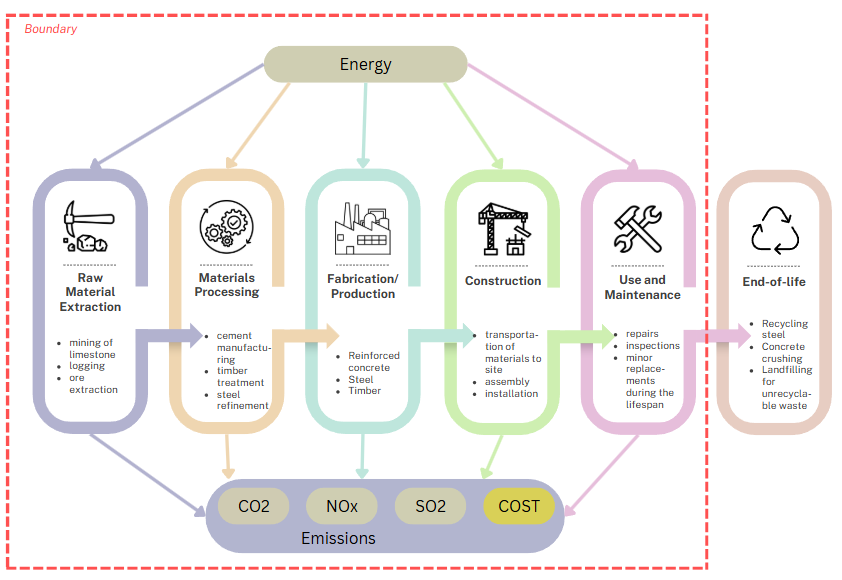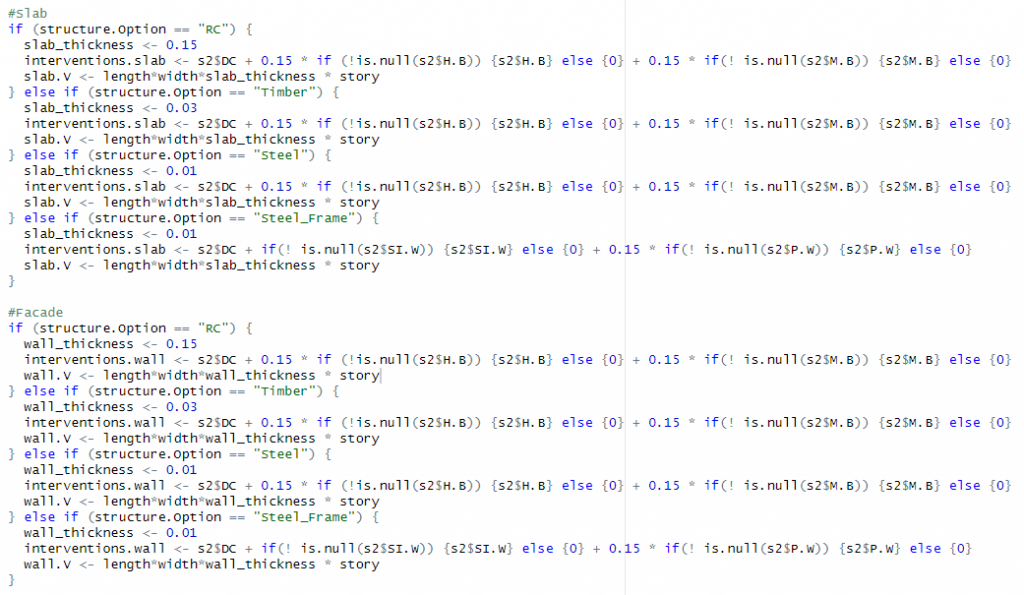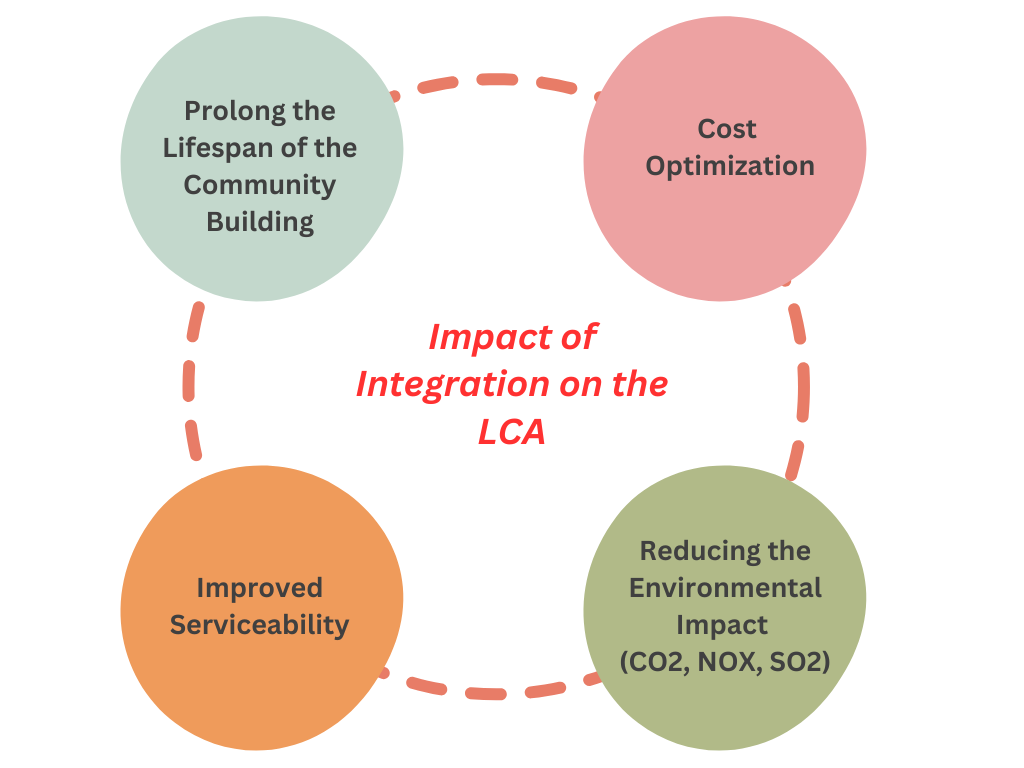Introduction
Life Cycle Analysis (LCA) is used to analyze the integrated context of our vibrant community. It is composed of three main Buildings such as Reinforced Concrete Office Building, Timber Student Dormitory, and Steel Multi-Story Residential Building. These systems have a central Steel-Frame Water Supply Facility that provides a reliable water source for the whole community.
The study adopts the LCA methodology, which evaluates the environmental impacts of materials and processes throughout their lifecycle. This method follows the ISO 14040 standards and includes four key phases: defining the goal and scope, creating a lifecycle inventory, assessing lifecycle impacts, and interpreting results.[1]
Figure 1. Life Cycle Framework
Scope and Goal
The main goal of this study is to evaluate and compare the environmental impact of these buildings, with a particular focus on carbon footprints and total costs associated with each environmental factor.
The scope and system boundary is limited to the pre-construction, construction, and operational phases, including raw material extraction, material processing, column fabrication, and operation and maintenance. The end-of-life stages are excluded due to a lack of data and resources. Also, the initial phases have significant environmental impacts and are necessary for identifying sustainable material choices.
Figure 2. Scope and System Boundary
Life Cycle Inventory
Table 1. Life Cycle Inventory Materials
Assumptions and Justifications
Emissions (CO₂, NOx, SO₂): For Reinforced Concrete Office Building, it is known that cement production is the main contributor to the environmental impact of concrete. Aggregates have minimal energy use and emissions, and the impacts of steel reinforcement are included based on the energy. For Steel-Framed Water Supply Facility and the Steel Multi-Story Residential Bulding, the same values were obtained from [2]. Lastly, the Timber has a negative carbon emission because wood stores carbon while growing. However, this will still depend on end-of-life treatment like burning or landfilling.
The NOx and SO₂ emissions are maily from transportation and processing which are quite low.
Quantities: Concrete materials are quantified in cubic meters, while the reinforcement is in kg. For Structural steel, it is quantified as kg. Timber is quantified in cubic meters and the steel dowels and bolts for the connections are in kg.
Life Cycle Impact Assement
Life Cycle Timeline
Establishing interventions and lifespan in LCA is important because it creates the sequential framework and scope for evaluating the environmental and economic impacts of the building. Different materials deteriorate at varying rates based on environmental exposure and usage. To ensure that the analysis represents the real-world performance of a material, it is necessary to consider the maintenance, repairs, and replacement.
Having these interventions visually present will also enable us to see the difference in performance between the materials (RC, Steel, Timber), making it easier to make decisions based on long-term impacts and costs.
According to Deetman et al. (2020) [3], the overall global estimated lifespan for residential and service-sector buildings is 60 years. Therefore, we set the total lifespan for each building at 60 years, with a strong emphasis on preventive maintenance to enhance durability, reduce failures, and optimize long-term performance.
Different maitenance strategies were analyzed and they can be found here: Integrated Maintenance Strategy
Emission Calculation Methodology
To determine total emissions, the volumes of key building elements—columns, beams, slabs, and facades—were calculated using the following:
Table 2. Building Dimensions of the Integrated System
Weighting is applied to the interventions on the slab and the facade wall to optimize the distribution of these actions based on their impact on the overall system.
Unit Cost of Energy and Emissions
To accurately assess the economic impact of emissions and energy consumption, it is essential to consider the unit costs associated with energy usage and pollutant emissions. These costs reflect the financial burden of environmental impacts, including CO₂, NOx, SO₂ which contribute to climate change and air pollution. Table 3 provides the unit costs for energy and emissions based on recent European and UK environmental reports:
Table 3. Unit Cost for Energy and Emissions

Energy Costs (€/MJ): Represents the cost per megajoule of energy used in material production, transport, and construction processes.
CO₂ Costs (€/tonne): The estimated economic impact of CO₂ emissions, reflecting carbon pricing mechanisms used to mitigate climate change.
NOx & SO₂ Costs (€/tonne): These pollutants contribute to acid rain and respiratory health issues. The high unit costs reflect the economic damage associated with air quality degradation and environmental remediation efforts.
Analysis Result and Interpretation
Based on the LCI calculations, the total environmental impact is as follows:
Figure 3. Total Energy, Emissions, and Cost
Interpretation:
Negative CO₂ emissions resulted to -79,666,834 tonnes indicate a significant carbon sequestration effect, primarily due to timber materials. This highlights the environmental benefit of using wood-based construction.
High NOx (1,489,306 tonnes) and SO₂ (646,951.9 tonnes) emissions shows that air pollution impacts must be carefully considered especially for steel and concrete-based structures.
The total cost of €24.89 million shows the aggregated financial burden of energy consumption and pollutant emissions over the building’s life cycle.
Impact of Integration on the LCA
- Prolong the Lifespan of the Community Buildings: Regular maintenance extends asset lifespan by preventing failures and reducing degradation.
- Cost Optimization: Optimizing the maintenance strategy minimizes costs by reducing redundancies and spreading expenses evenly.
- Reducing the Environmental Impact: Maintenance decreases material waste, energy use, and emissions (CO₂, NOx, SO₂) by avoiding major repairs and promoting sustainable practices.
- Improved Serviceability: If maintenance is strategically planned, it can minimize downtime and ensures systems operate efficiently.
References
[1] Klöpffer, W., & Grahl, B. (2014). Life cycle assessment (LCA): A guide to best practice. Wiley-VCH.
[2] Beandie M. Sebastian. (2017), The Steel Recycling Insititute. LCI Data for Steel Products. https://www.steel.org/wp-content/uploads/2020/11/HDG-NA-LCI-Report.pdf
[3] S. Deetman, S. Marinova, E. van der Voet, D.P. van Vuuren, O. Edelenbosch, R. Heijungs. (2020). Modelling global material stocks and flows for residential and service
sector buildings towards 2050, J. Clean. Prod. 245, 118658, https://doi.org/10.1016/j.jclepro.2019.118658
[4] Eurostat. (2024). Electricity price statistics. European Commission. Retrieved January 27, 2025, from https://ec.europa.eu/eurostat/statistics-explained/index.php?title=Electricity_price_statistics
[5] Umweltbundesamt. (2023). Environmental unit cost lists 2023. Umweltbundesamt. Retrieved January 27, 2025, from https://www.umweltbundesamt.de/sites/default/files/medien/11850/publikationen/159_2023_texte_environmental_unit_cost_lists.pdf
[6] Department for Environment, Food & Rural Affairs (DEFRA). (2023). Damage cost update 2023. DEFRA. Retrieved January 27, 2025, from https://uk-air.defra.gov.uk/assets/documents/reports/cat09/2301090900_Damage_cost_update_2023_Final.pdf





